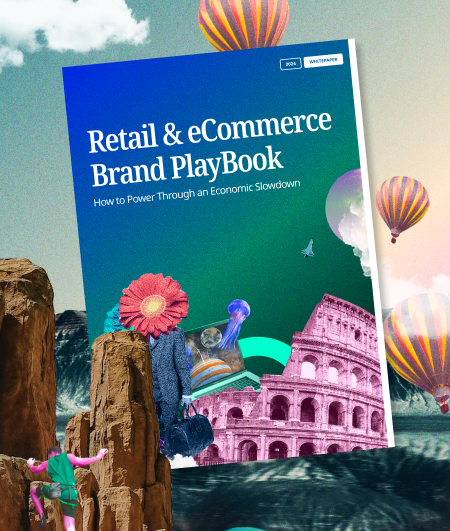We live in a world full of distractions. Consumers are inundated with options and noise. For growing businesses, standing out is no longer just an aspiration; it’s a survival instinct. Enter branding – that artistic and strategic blend of visuals, messaging, and experience that can elevate a business from mere existence to meaningful recognition.
This article explains what it means to brand effectively, and how a scaling enterprise can leverage brand to its full advantage.
But First, What is Branding?
Branding is the soul of your business; it’s the expression of your values, your personality, and ultimately, what separates you from the competition. For startups taking their first steps, establishing a solid brand is not just beneficial; it's imperative in carving out a niche for your venture. But why exactly is it so vital, and how do you begin to fashion a brand that resonates and endures?
Your brand is more than a logo or a jingle. For your audience, it’s both their first impression of your business and something they’ll continue interacting with. To make your mark in a crowded marketplace, branding must be approached not as a ‘nice-to-have’, but as a foundational business process.
Branding for Customer Trust and Loyalty
Every interaction is an opportunity to reinforce who you are. Over time, consistent branding becomes a visual shorthand for your customers, signifying reliability, trust and credibility. It's what pops into a customer's mind when they think of you (or better yet, your category or even competitors) and what underlines your authenticity.
Perceived Quality and Trust
Your brand should reflect the quality and ethics you embody as a business. Whether it's environmentally conscious practices, corporate philanthropy , or a focus on customer service, your brand should shout what’s great about you, without you needing to shout at all.
Branding & Visual Identity Drives Recognition
Consistency in branding across all touchpoints reinforces brand recall. With a strong identity, customers will recognise and remember you amidst the cavalcade of competitors, which is half the battle of winning their hearts and minds.
Creating a Unique Value Proposition
In a world where a thousand voices are jostling for attention, being heard comes down to what you stand for. Your brand should communicate it clearly and compellingly, showing that you practise what you preach. It’s here where branding is less about selling features and more about a story, an emotional connection that can lead to fierce loyalty.
When your brand resonates with customers on an emotional level, it’s more than a transaction; it's a relationship. A brand that understands and values its customers not only survives in a competitive arena but thrives on repeat purchases and customer advocacy.
How Strong Brands Stand Out in the Crowd
There’s nothing more persuasive than a success story, and what better triumphs to cite than those of brands who have cultivated identities that echo through homes and hearts globally.
Airbnb: “Belong Anywhere”
Airbnb didn’t just create a platform for finding a place to stay; it instigated a global movement based on belonging, adventure, and authentic experiences. Its branding is a blend of visuals and messaging that speaks to the intrepid traveller who seeks more than just shelter but a story.
Nike: “Just Do It”
With a symbol that became synonymous with victory and a slogan so charged with possibility, Nike’s branding resonates beyond selling sneakers. It sells dreams of athleticism, inspiration, and inclusion, compelling people to just do it, whatever 'it' might be.
Apple: “Think Different”
Apple’s branding strategy is a masterclass in creating an experience with a product. The clean design aesthetic and user-friendly functionality are not just traits; they’re the brand’s promise mirrored in everything from its packaging to the tech within. It’s not just about owning a device; it’s about becoming part of the story Apple unfolds with each interaction.
Implementing a Brand Strategy: 9 Steps to Brand Visibility
Understood and inspired? Now begins the journey of translating these ideas into actionable steps for your business. And no, branding is not just for big business. Here's your roadmap to capturing the essence of your brand and projecting it into a sea of potential customers.
1. Define Your Audience
Before you can speak to someone, you need to know who you’re trying to reach and what they care about. Develop a deep understanding of your target audience to form connections that are genuine and resonate on a personal level.
2. Discover Your Market
Understanding the market is critical when developing a brand strategy. Whether you're a B2B, B2C or D2C brand, you should be well versed in market discovery techniques from qualitative and quantitative practices such as customer interviews, data analysis, focus groups, and product reviews. This way you can understand what resonates with your audience and what your brand means to them.
3. Market Segmentation
With a clear understanding of what customers make up the market, the next step is to identify pockets of the market which have different behaviours, and potentially different propensity to purchase. This can be helpful in determining who to target, who not to target, and why, ensuring you spend your advertising budgets wisely.
4. Develop Your Brand’s Personality
Your brand needs a personality as unique as your fingerprint. Is it bold, irreverent, and always challenging the status quo? Or is it thoughtful, reliable, and the quiet voice of reason? Decide, and then embody it at every opportunity.
5. Craft Your Visual Brand Identity
Colours, logos, fonts — the visual cues of your brand need to be cohesive and consistent, reflecting the personality you've chosen. Keep it simple, memorable, and reflective of the story you're telling.
6. Tell Your Story
What’s the driving force behind your brand? Share your narrative; be it a celebration of craftsmanship, a commitment to the environment, or a vision of the future. Your story is as compelling as any product, and it's yours to tell.
7. Be Consistent Across All Touchpoints
Whether it’s a social post, an email, or a billboard, the voice and visuals of your brand should remain consistent. Being good at CX requires a commitment to uniformity builds recognition and trust.
8. Create Memorable Experiences
Make customer encounters with your brand memorable. It’s the little extras, the surprises, and the moments you create that define your brand in your customer's mind.
9. Adapt and Evolve
A brand that never changes is a brand that's left behind. Continuously evaluate your brand's performance, listen to your audience, and be prepared to evolve while remaining aligned with your core values.
We Love Branding! Let Our Experts Help You Create Yours
Branding is not a surface-level paint job you slap on your business before presenting it to the world; it’s the roots that ground you and the tree you become. The brands that endure are not just attractive; they're living organisms, breathing, adapting, and connecting.
For the entrepreneurs who have yet to dip their toes in the branding waters, small businesses making fledgling efforts, or established brands in need of a refresh, we’re here to help you take your brand to new heights. Get in touch with our Brand and Marketing experts today.






